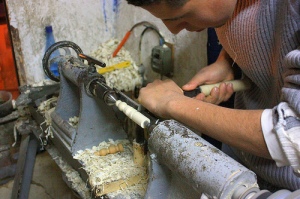Oliver Walton is a research fellow in the Governance and Social Development Resource Centre. His areas of interest include NGO legitimacy, civil society peacebuilding, conflict prevention, war-to-peace transitions, and Sri Lankan politics. This post discusses the findings of a new research report on Youth, armed violence and job creation programmes carried out for the Norwegian Peacebuilding Centre.
In recent years, youth job creation programmes have become a popular tool for addressing armed violence and conflict. Many donors now see tackling youth unemployment as an urgent priority in their efforts to reduce armed violence, build peace and promote economic development. Our research sought to examine the success of youth job creation programmes in reducing armed violence. It found that the both the theoretical and the empirical basis for using youth employment programmes as a tool for reducing armed violence and armed conflict was extremely weak.
Theoretically, the notion that job creation alone can reduce armed violence is unconvincing. The literature suggests that there are multiple motivations for youth engagement in armed violence, that these need to be understood in relation to each particular context, and that there may be considerable variation in the motivations of individual youth within any given context. In-depth case studies suggest that while youth unemployment may provide part of the explanation of why armed violence occurs, this factor is rarely a main or direct cause of violence. Even where youth employment may be a factor, its relationship to violence is complex and multi-faceted and should not simply be understood in opportunity-cost terms. Evidence suggests that although frustration at a lack of livelihood opportunities can play a part in motivating youth violence, social and political grievances are usually more central.
 Photo credit: austinevan
Photo credit: austinevan
A young boy manufacturing chess pieces in a small shop above a warehouse in the souks of Marrakech
Donor interventions have been poorly evaluated and evidence of success is usually limited to demonstrating increases in employment levels, with very few evaluations assessing the impact on violence. The small number of studies that have assessed the impact of these programmes on levels of violence tend to show that the impact of these programmes is quite limited. The evidence on using job creation as part of an integrated or comprehensive armed violence reduction strategy is stronger: some government-led initiatives in countries that experience high levels of armed violence (such as Brazil and South Africa) have shown clear positive results in reducing levels of armed violence.
The research finds that donor approaches to reducing armed violence through job creation schemes have become more nuanced and sophisticated. There has been a growing emphasis on ‘holistic’, ‘comprehensive’ and ‘integrated’ approaches that go beyond simply addressing a lack of economic opportunities and seek to address the more complex array of factors that cause social exclusion for young people. These initiatives combine job-creation schemes with a range of other forms of intervention, such as capacity-building and training in conflict resolution. Donors have also sought to make job creation schemes more effective by conducting better contextual analysis. They have also looked to improve the effectiveness and relevance of these schemes by working more closely with the private sector and tackling the demand-side of youth unemployment. Despite this progress, there is a still a significant gap between donor rhetoric and practice in this area.
The research identifies a number of best practices from the academic, evaluative and policy literature:
- Youth job-creation schemes should be based on thorough contextual analysis of the prevailing local economic, social and political conditions.
- Donors should pursue comprehensive or holistic approaches that integrate youth issues into existing development programmes.
- Young people should be involved in project design, monitoring and evaluation.
- Youth employment programmes should involve strategies for addressing the social and political marginalisation of young people.
- The private sector should be involved in programme design; particularly in ensuring training courses are relevant and meet market demands.
- It is important to balance a ‘deficit’ or security-oriented approach to youth with a focus on the positive role youth can play as peacebuilders or engines of social and economic recovery.
- Youth employment and DDR programmes should involve conflict resolution training components.
- Donors should seek to build the capacity of youth organisations which provide a space for young people to meet and express their views.
For more information, please see the complete report on Youth, Armed Violence and Job Creation Programmes.
